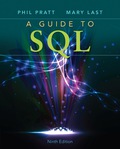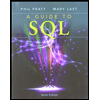
Concept explainers
“SELECT” command:
The “SELECT” command is used to retrieve data in a
Syntax for selecting values from the table is as follows:
SELECT STUDENT_ID FROM STUDENT;
- The given query is used to display each student ID from “STUDENT” table.
“COUNT” function:
- It is the one function of aggregate function.
- The “COUNT” function is used to compute the number of rows in a table.
Example:
The example for “COUNT” function is given below:
SELECT COUNT(*) FROM STUDENT WHERE MARK_CREDIT >= 90;
The above query is used to display the number of students whose mark credit is greater or equal to “90” by using “COUNT” function.
- From the given query, the asterisk (*) represent any column.
- User can also count the number of rows in a query by selecting a particular column instead of using the asterisk.
- The below example is as follows
SELECT COUNT(STUDENT_ID) FROM STUDENT WHERE MARK_CREDIT >= 90;
- The below example is as follows
“ORDER BY” Clause:
- User can sort the data in specific order using “ORDER BY” clause.
- The column on which to sort data is called a sort key or a simple key.
- To sort the output, use an “ORDER BY” clause followed by the sort key.
- If the user does not indicate a sort order, the output displayed in default order that is ascending order.
Example:
The example for “ORDER BY” clause is given below:
SELECT STUDENT_ID, STUDENT_NAME, STUDENT_CREDIT FROM STUDENT ORDER BY STUDENT_CREDIT;
The above query is used to list student ID, name and credit for each student with ascending order of student credit using an “ORDER BY” clause.
- From the given query, the sort key is “STUDENT_CREDIT”. So, the rows are sorted in ascending order by “STUDENT_CREDIT”.
“GROUP BY” Clause:
- User can group the data using “GROUP BY” clause.
- The GROUP BY clause is used to group the result of a SELECT statement done on a table where the tuple values are similar for more than one column.
Example:
The example for “GROUP BY” clause is given below:
SELECT CUSTOMER_NAME, SUM(AMOUNT) FROM CUSTOMERS GROUP BY CUSTOMER_NAME;
The above query is used to list the customer name and the sum of amount using “GROUP BY” clause.
Want to see the full answer?
Check out a sample textbook solution
Chapter 4 Solutions
A Guide to SQL
- COIS-3050H-R-W01-2025WI-COMB Formal ministic PDA. Are the following words accepted by this Languages & Automata UI MIUSɩ that aTU I ed, indicate which state the PDA is in when the crash occurs. (a) aabbaa (b) aaabab (c) bababa Start (d) aaaabb A Accept Read₁ Push a (e) aaaaaa a b Read, Popi a a,b A Read₂ Accept A Pop₂arrow_forward5) Eliminate the A-productions from the following CFG: Abc COIS-3050H-R-W01-2025WI-COMB Formal Languages & Automata BAabC C CaA | Bc | A 6) Convert the following CFG into CNF. S→ XYZ XaXbS | a |A YSbS | X | bb Z→ barrow_forwardNeed help answering these questions!1. Design a While loop that lets the user enter a number. The number should be multiplied by 10, and the result stored in a variable named product. The loop should iterate as long as the product contains a value less than 100. 2. Design a For loop that displays the following set of numbers: 0, 10, 20, 30, 40, 50 . . . 1000 3. Convert the While loop in the following code to a Do-While loop: Declare Integer x = 1 While x > 0 Display "Enter a number." Input x End Whilearrow_forward
- Need help with these:Design a While loop that lets the user enter a number. The number should be multiplied by 10, and the result stored in a variable named product. The loop should iterate as long as the product contains a value less than 100. 2. Design a For loop that displays the following set of numbers: 0, 10, 20, 30, 40, 50 . . . 1000 3. Convert the While loop in the following code to a Do-While loop: Declare Integer x = 1 While x > 0 Display "Enter a number." Input x End Whilearrow_forwardConvert the While loop in the following code to a Do-While loop: Declare Integer x = 1 While x > 0 Display "Enter a number." Input x End Whilearrow_forwardPython - need help creating a python program that will sum the digits of a number entered by the user. For example if the user inputs the value 243 the program will output 9 because 2 + 4 + 3 = 9. The program should ask for a single integer from the user, it should then calculate the sum of all the digits of that number and output the result.arrow_forward
- I need help with this in Python (with flowchart): Im creating a reverse guessing game. Then to choose a random number from 1 to 100 and the computer program will attempt to guess it, displaying the directions calculated or not. The guess will be displayed and the user will answer if it was correct or not. If correct, the game ends, if not then the computer asks if the guess was too high or too low. Finally inputting an answer and the computer generates a new guess within the proper range. Oh and to make sure the program doesnt guess outside of the ranges produced by the inputs of “too high” and “too low”. The program ending when the user guesses correctly or after the program takes 6 guesses. HELP ASAP!arrow_forwardI need help with this in Python (with flowchart): Im creating a reverse guessing game. Then to choose a random number from 1 to 100 and the computer program will attempt to guess it, displaying the directions calculated or not. The guess will be displayed and the user will answer if it was correct or not. If correct, the game ends, if not then the computer asks if the guess was too high or too low. Finally inputting an answer and the computer generates a new guess within the proper range. Oh and to make sure the program doesnt guess outside of the ranges produced by the inputs of “too high” and “too low”. The program ending when the user guesses correctly or after the program takes 6 guesses. HELP ASAP!arrow_forwardNeed help finding errors in my pseudocode (Two)! Declare Boolean finished = False Declare Integer value, cube While NOT finished Display "Enter a value to be cubed." Input value; Set cube = value^3 Display value, " cubed is ", cube End While Next, I intended the following pseudocode to display the numbers 1 through 60, and then display the message "Time’s up!". Doesnt work and has error. Declare Integer counter = 1 Const Integer TIME_LIMIT = 60 While counter < TIME_LIMIT Display counter Set counter = counter + 1 End While Display "Time's up!"arrow_forward
- Having error in pseudcode; wanting to get five sets of two numbers each, calculate the sum of each set, and calculate the sum of all the numbers entered. Not functioning as intended and can't find the error.Code: // This program calculates the sum of five sets of two numbers. Declare Integer number, sum, total Declare Integer sets, numbers Constant Integer MAX_SETS = 5 Constant Integer MAX_NUMBERS = 2 Set sum = 0; Set total = 0; For sets = 1 To MAX_NUMBERS For numbers = 1 To MAX_SETS Display "Enter number ", numbers, " of set ", sets, "." Input number; Set sum = sum + number End For Display "The sum of set ", sets, " is ", sum "." Set total = total + sum Set sum = 0 End For Display "The total of all the sets is ", total, "."arrow_forwardNeed help converting loops!1. Convert the following While loop to a For loop: Declare Integer count = 0 While count < 50 Display "The count is ", count Set count = count + 1 End While _________________________________________________ 2. Convert the following For loop to a While loop: Declare Integer count For count = 1 To 50 Display count End Forarrow_forwardNeed help making this!1.Design a nested loop that displays 10 rows of # characters. There should be 15 # characters in each row. 2. Design a nested set of for loops that displays the following arrangements of ‘X’ characters X XX XXX XXXX XXXXX XXXXXXarrow_forward
 A Guide to SQLComputer ScienceISBN:9781111527273Author:Philip J. PrattPublisher:Course Technology Ptr
A Guide to SQLComputer ScienceISBN:9781111527273Author:Philip J. PrattPublisher:Course Technology Ptr

